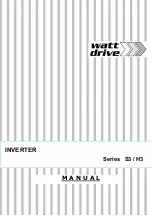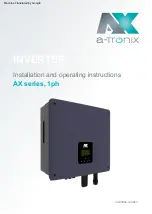
Fault
Possible cause
Explanation/remedy
By
In spite of high radiation
levels, the inverter does
not feed the maximum
power into the grid.
Particular ambient con-
ditions.
Because the temperatures inside the unit are too high, the de-
vice reduces its power to prevent damage to the device. Note
the technical data. Ensure that the convection cooling is not
impeded from the exterior. Do not cover the cooling fins.
› Ensure sufficient cooling of the device.
B
› Remove any foreign bodies that may be on the device.
B
› Clean the cooling fins
E
DC fuse defective
A generator string is disconnected from the device due to a de-
fective fuse. Establish the cause of tripping by measuring all DC
strings with a clip-on ammeter. - If there is no current flowing
in a string, then the associated DC fuse is defective.
Check the no-load voltage and layout of the PV generator. Re-
place the damaged modules if necessary.
B, E
› Replace the PV fuse with a fuse size that is of the same type.
Tab. 10:
Troubleshooting
11.8
Fault messages
Fault LED (red)
Status
Explanation
LED
FS (fault status)
The fault relay has switched.
On
Feed-in was ended due to a fault.
OS (operating status)
The fault relay releases again.
Off
The device feeds back into the grid again after a country-
specific time period.
11.9
Troubleshooting
The following table lists the possible status and fault messages, the ProLog© status messages that the device can display
by means of the LC display / web interface and the LEDs.
KACO blueplanet 87.0 TL3 KACO blueplanet 92.0 TL3 KACO blueplanet 110 TL3 KACO blueplanet 125 TL3
KACO blueplanet 137 TL3 KACO blueplanet 150 TL3
Page 96
EN-US















































